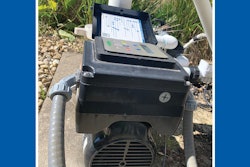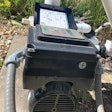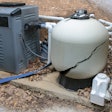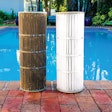
Some filters you never have to clean. Coffee filters, for instance – you just throw away the filter media and replace it with fresh. But in the pool and spa world, the arduous task of cleaning filter media is a regular part of maintaining a pool with sparkling water.
So, of course, we make the best of it and do the job as efficiently as possible.
The state of filtration is always changing, with additives and new technology, such as pre-filters, making the equipment more effective or easier to manage. One trend, which is steadily improving filtration, is the steady adoption of variable-speed pumping throughout the industry.
The variable-speed movement is decades old, but the DOE pump regulations that came into force in July of 2021 eliminated the manufacture of all but a few single-speed models, and gave the transition to variable-speed pumps a mighty shove.
How does that help service pros clean filters? One of the most common causes of early filter death and difficult filter cleaning is deeply embedded debris, which is caused by high line velocities. Slower circulation speeds provided by variable-speed pumps obviate this problem, and also help prevent algae growth by decreasing the length of time that water sits dead in the pool.
In general, now that the DOE regulations have been implemented and more variable-speed pumps are being installed, both in new construction and as replacements, line velocities are slowing throughout North America and debris is settling more comfortably on the surface of filters where it can be more easily rinsed away — instead of being driven deep into the media.
At the same time, the VSP era has created a bit more nuance in determining when to clean. A rule of thumb for many pros is to clean the filter when the tank pressure is 8 to 10 psi over the reading when it was clean. In the single-speed era, that was easy to determine, since there was only one speed. But variable-speed pumps run at... variable speeds, so a single reference speed is now needed.
Today, many service technicians turn up the pump to the highest pre-set circulation speed (not the highest speed on the pump) for their clean vs dirty pressure comparison.
TOO SOON
Timing is important. You can clean too often. A filter reaches its optimum performance after a layer of debris builds on the surface of the media, called the filter cake. This actually helps it filter better by straining out even more and finer material.
It may be called cake, but don’t eat it. It doesn’t taste good.
On the other hand, clean too late, when too much debris has built up on the filter, and now you’re clogging flow, overworking the pump, wasting energy, consuming chlorine unnecessarily as debris is retained, and putting stress on the filter itself, whether it’s sand, cartridge or D.E.
Dirty filters cause a host of problems, large and small, and some you may not have even thought of. For instance, by keeping filters from getting clogged, you avoid a familiar headache on spas: a callout to a spa customer to deal with a heater that has shut down due to insufficient flow.
SAND
Sand is the easiest filter to clean, because you don’t have to disassemble anything — you don’t have to open up the tank. You just switch the valve to backwash and start running the pump until the wastewater runs clear, usually something in the neighborhood of three to five minutes, plus or minus.
Sand filters make up for this ease of regular cleanings on the day the sand filter media itself has to be changed. You notice the loss of media performance as the sand reaches the end of its useful lifespan, typically between three to five years, perhaps longer depending on bather load and care.
Changing out the sand is usually a difficult chore, as old sand will likely have a hard crust on top that must be broken, and then the sand must be removed either by scooping, vacuuming or pouring through a drain port in the bottom.
Cleaning out the sand will involve some stretching and reaching through the hole at the top of the filter, and awkward maneuvering around the barrel-like tank. If possible, some techs prefer to remove the tank from the plumbing (which takes extra time), tip it over and try to pour/rinse the sand out.
More grueling and backbreaking is the straightforward approach of reaching in through the hole in the top and just scooping it out, one scoop at a time, and dumping the used sand into a bag.
Once you get most of the sand out, if you have a drain port in the bottom, you can rinse the dregs out through there.
Note: When refilling the sand filter, it’s crucial to maintain “head space” above the sand bed. That space is intended to dissipate the turbulence of the incoming flow and produce steady, even water pressure over the sandbed. Without that head space — with uneven pressure across the sand bed — channeling will result. That is, water will deviate through the channel without enjoying the full-filter experience.
CARTRIDGE
Cartridge cleaning is longer and harder than a sand backwash because you have to open up the tank. Fortunately, nowadays, cartridges need to be cleaned less frequently than they used to. Twenty years ago, cartridge filter assemblies were relatively small and needed to be cleaned far more often, but engineers at the major manufacturers caught on to the idea that a larger filter would mean more filter area, which would mean they could go longer before servicing. This is one of the factors that has led to a gain in market share for cartridge filtration over time.
The hard thing about cleaning a cartridge is it presents a somewhat difficult surface. Cartridge media is something like a circular accordion, presenting deep pleats to the cleaner, which, while increasing the filter surface area dramatically, are inherently hard to access. You have to get in between those pleats with water to clean it.
In cartridge-dominated areas, where most pools use cartridge filters, working on a disciplined system of cartridge cleaning can make this job more thorough and a lot faster. And over the course of a year, shaving just a few minutes from a process that is performed hundreds of times can save hundreds of hours. It’s worth an investment in efficiency in your method and/or specialized tools.
In cleaning a cartridge filter, you just shut down the pump and open up the pressure bleeder on top of the unit, take off the band and the top of the tank, pull out the four cartridges and get to work spraying them off. A service pro might spend 15 minutes or so cleaning off the cartridges, slowly working from top to bottom, rinsing the brown gunk off the white fabric.
Instead of just using the threaded male coupling you find at the end of a garden hose, or a screw-on hose nozzle, many techs save time using one of the commercial devices that screw onto the end of the hose, with individual tines that put cleaning water right into the pleats of the cartridge filter fabric. It saves time because you’re focusing all the water right where it should be.
The customer may not have a hose hooked up in the backyard, in which case the prepared service pro simply connects their own hose, with specialized cartridge-cleaning head already attached, and commences the business of rinsing.
D.E.
A full cleaning of a D.E. filter means three steps: backwash, cleaning the grids, and adding new D.E.
D.E. filters should be backwashed in much the same way as sand filters, but some pros recommend breaking down the cycle into a one-minute backwash, then a one-minute filtration for three separate cycles (making sure you shut the pump off each time you switch between backwash and filtration). This procedure helps to separate the D.E. coating from the grids so it can be removed from the filter. With the backwash complete, remove the clamp that holds the filter together, pop off the lid and remove the grids one at a time. Hose out the tank and hose off the grids. Try to capture the main portions of the D.E. and put them in garbage bags to be disposed of. It’s messy stuff.
Clean and lubricate the tank O-ring and the O-ring seat, then reassemble everything from the grids to the lid. Put the clamp on and tighten it to the manufacturer’s specifications. Put the drain plug in, turn the system back on, bleed the air out and close the air relief.
The D.E. that was washed away needs to be replaced, of course. The proper way to do this is to use a 5-gallon bucket, and then add water and D.E. together to create a slurry. Slowly pour the slurry into the skimmer while the pump is running. This will ensure that the grids or elements are properly coated from top to bottom.
THE CRUSTY AND THE OILY
There are products that are specifically geared to break down the grease, oil and crusty things that are always found in filters.
Acid cleaners can tackle crusty calcium, but for oily substances that block filtration but refuse to rinse out, a basic (as in high pH) cleaner is the answer. Pool bathers are inevitably covered in oils of various types, from coconut to natural skin oil, and as oil and water don’t mix, these substances are reluctant to rinse out of a filter.
Soaking cartridge filters in a cleaning solution definitely allows you to do a more complete job of cleaning the filter.
Some service departments/ companies have this process organized and systemized so that dirty cartridge filters at individual homes are replaced with clean ones on the spot, while the dirty ones are tossed in the van and brought back to the home base for mass production cleaning, including a good soak, spray down and a chance to dry properly and fluff up the pleats.
BACKBONE OF WATER MAINTENANCE
Filtration is the backbone of an overall water quality program, which includes treatment, both chemical and perhaps boosted by sanitizing equipment, such as UV, ozone and AOP, physical removal of debris through skimming and netting and automated systems, pool covers and even bather cleanliness education.
And without a rigorous, disciplined program of filter cleaning, filtration will provide a weak backbone at best.
The objective, as always, is to make the water attractive but also safe from waterborne pathogens. Everything in the industry comes back to water quality. Customers with unsatisfactory water aren’t going to recommend you to their friends and family. On the other hand, those with brilliant sparkling water serve as a constant advertisement for the industry and your business.
This article first appeared in the April 2023 issue of AQUA Magazine — the top resource for retailers, builders and service pros in the pool and spa industry. Subscriptions to the print magazine are free to all industry professionals. Click here to subscribe.









































